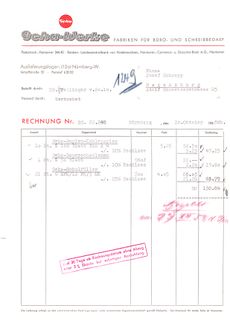Geha
| Geha |
|---|
| Pagine marca |
| Foto marca |
| Foglietti istruzioni |
| Altri documenti |
| Brevetti |
The company was founded in 1918 in Hanover by Heinrich and Conrad Hartmann, the name is short for Gebrüder-Hartmann (Hartmann brothers).[1] The company was founded specializing in the production of material for stationery, especially paper, blocks, carbonless papers and tapes, becoming in the 20s one of the market leaders in stationery postal sales.
Geha entered the fountain pen market in 1950, with the production of economic pens made for the student market called Regent, featuring a band with the company logo. The distinguishing feature of the Geha pens was the use of a piston filler equipped with a special ink reservoir (see patents nº GB-666830 and nº DE-958812) that allowed an emergency reserve to be maintained, usable by pushing a pin located under the feeder.
In 1957 the production was reorganized, the ring with the logo was removed, changing to a simple ring on the cap edge, and introducing a classification of price range based on the number of rings placed over the cap. The pens were still identified, as for the previous Regent by a three-digit numerical code, and mostly named Geha-Schulfüller.
A partire dal 1962 vennero prodotti modelli con pennino intarsiato (brevetto nº DE-1161500) simili a quelli della PFM della Sheaffer, denominati Goldschwinge. Nel prosieguo degli anni '60 vennero prodotte diverse varianti, e linee più economiche di penne a pennino carenato. Resta come distintivo il sistema di caricamento a stantuffo con il meccanismo della riserva di inchiostro. A partire dal 1961 vennero anche introdotti dei modelli con caricamento a cartuccia, mantenendo la riserva di inchiostro grazie all'uso di due cartucce separate (vedi brevetto nº DE-1215025) come per la Duo-Cart dell'Aurora.
Negli anni '70 la produzione di stilografiche venne sempre più orientata alle linee economiche per gli studenti, restando comunque marginale nelle attività dell'azienda che dal 1972 si specializzò in macchine copiatrici e lavagne luminose. Nel 1990 la Geha venne acquisita dalla Pelikan, restando comunque una produzione di penne con marchio proprio, all'interno di quella della Pelikan.
External references
- [1] Wikipedia Germany company page
- [2] Brief history on the company website
- [3] Website dedicated to the company (in German)
